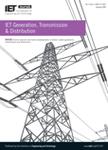版权所有:内蒙古大学图书馆 技术提供:维普资讯• 智图
内蒙古自治区呼和浩特市赛罕区大学西街235号 邮编: 010021

作者机构:Sao Paulo State Univ Dept Elect Engn POB 31Ave Brasil Ctr 56 BR-15385000 Ilha Solteira SP Brazil Univ Estadual Campinas Dept Syst & Energy Ave Albert Einstein 400 BR-13083852 Campinas SP Brazil
出 版 物:《IET GENERATION TRANSMISSION & DISTRIBUTION》 (IET Gener. Transm. Distrib.)
年 卷 期:2016年第10卷第12期
页 面:3023-3032页
核心收录:
基 金:CNPQ CAPES Sao Paulo Research Foundation (FAPESP) [2014/23741-9] Fundacao de Amparo a Pesquisa do Estado de Sao Paulo (FAPESP) [14/23741-9] Funding Source: FAPESP
主 题:load flow reactive power power transmission planning power system security integer programming linear programming MILP branch flow model concurrent AC multistage transmission expansion reactive power planning security constraints mixed-integer linear programming TNEP simultaneous transmission network expansion planning reactive power planning problem RPP problem off-nominal bus voltage magnitudes power losses classical optimisation methods steady-state operation points AC load flow method Garver 6-bus system modified IEEE 118-bus system
摘 要:This study presents a mixed-integer linear programming (MILP) model to solve the simultaneous transmission network expansion planning (TNEP) and reactive power planning (RPP) problem. The proposed model considers reactive power, off-nominal bus voltage magnitudes, power losses, multistage expansion, and security constraints. The use of an MILP model guarantees convergence to optimality by using existing classical optimisation methods. In order to validate the approximation performed, the steady-state operation points were compared with those obtained using an AC load flow method. Garver s 6-bus system and a modified IEEE 118-bus system were used to show the precision and efficiency of the methodology. The results indicate that better expansion and generation plans are found by considering RPP simultaneously with the AC TNEP, when the solutions were compared with the plans of the TNEP using the AC model without RPP and the TNEP considering the DC model, with RPP conducted at a subsequent stage.